|
As North Carolina goes, so goes America?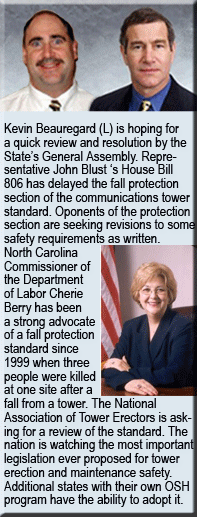
NC to enforce new tower standard May 1st as the nation carefully watches
May 1, 2005 - North Carolina's Department of Labor will be enforcing the State's new communications tower standard on May 1st. Unfortunately, it will be missing two of its key safety sections that were authored to help prevent serious injury or death, according to Assistant Occupational Safety and Health Deputy Commissioner Kevin Beauregard who has spearheaded the new legislation at the direction of North Carolina Commissioner of Labor Cherie Berry. Fall Protection (13 NCAC 7F.0605) and Non-Ionizing Radiation (13 NCAC 7F.0606) will not be included in inspection activity and NCDOL outreach programs starting this week.
Beginning in 1999, Commissioner Berry became the nation's safety conscience as the most vocal proponent for a state and possibly federal consensus standard to protect a tower erector's and maintenance technician's safety. The nation's first death in 2005 from falling from a tower occurred in Wilson County, NC on February 25. During the standard's review period, industry associations such as the National Association of Tower Erectors (NATE), the Personal Communications Industry Association (PCIA) and individual tower erection and maintenance companies, felt the fall protection standard could expose employers to violations for safety standards over which they have no control.
During public discussions, ladder rung and step bolt spacing that already exist on the tower are not areas that personnel have any jurisdiction in enforcing, according to NATE. The most current standard states: "Where step bolts are installed as the climbing facility, they shall conform to the criteria in 29 CFR 1910.268(h)(2), be uniformly spaced throughout the climbing length and shall be no more than 18 inches alternately spaced."
The association also cited that North Carolina's requirement to have two employees certified in basic first aid and cardiopulmonary resuscitation on site was unnecessary and too restrictive for smaller erection companies to comply with. They also cited similar concerns with the high angle rescue requirements.
The fall protection standard approved by the Rules and Review Committee can be viewed at: North Carolina Fall Protection Standard .
Personnel training requirements are primary concerns
Assistant Commissioner Beauregard believes that many of the industry's concerns were addressed and resolved during multiple meetings and comment periods, agreeing with NATE's concerns that two of the major issues had to do with the number of people that were required to be trained in high angle rescue as well as in first aid and CPR.
"Originally, we required that two employees had to be trained in high angle rescue, first aid and CPR," Beauregard said, "but after numerous discussions, it was agreed that there should only be a requirement for one as long as the contractor had designated another employee for training."
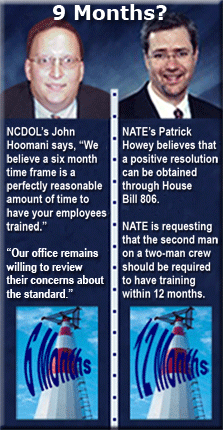 The final North Carolina standard requires that the contractor must "Ensure at least two trained and designated rescue employees are on site when employees are working at heights over six feet on the tower, provided however, where there are only two employees on site, then an employer may comply with the requirements of this Part if one employee is a trained and designated rescue employee and one employee has been designated by the employer as a probationary employee and has been employed for less than six months." The final North Carolina standard requires that the contractor must "Ensure at least two trained and designated rescue employees are on site when employees are working at heights over six feet on the tower, provided however, where there are only two employees on site, then an employer may comply with the requirements of this Part if one employee is a trained and designated rescue employee and one employee has been designated by the employer as a probationary employee and has been employed for less than six months."
Blust's bill puts standard on hold
North Carolina State Republican Assemblyman John Blust was approached by NATE' and championed the communication industry's concerns, introducing House Bill 806 on March 21, 2005. It requested disapproval of the State's Rules Review Commission's approval of the fall protection section, one of nine sections of the communications tower standard. Had Blust not submitted his eleventh hour bill on the last filing day, the section would have been effective April 1, 2005.
Proponents and opponents of the fall protection standard believe that it is close to becoming a reality, but tower industry representatives are still seeking changes.
NATE Administrator Patrick Howey said that he was pleased that this portion of the standard was kept in abeyance.
"We look forward to continuing our work with NCDOL to enhance safety for tower climbers in North Carolina. We are hopeful that House Bill 806 will create an opportunity to promote a greater understanding of the realities of communication tower rescue training, and how safety can best be achieved in this area," explained Howey, who along with others, believes that a positive resolution can be attained.
According to Don Doty, Chairman of the NATE OSHA Relations Committee and Vice Chairman of the tower erectors association, "Most important among NATE's concerns is the issue of when an employee is prepared to receive and effectively utilize rescue training."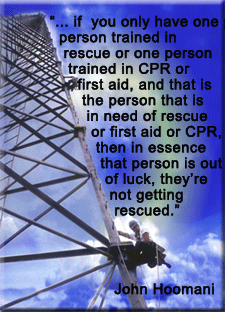
Doty is joined by other tower erection company owners who have followed the standard's revisions. They think that six months is too ambitious of a deadline to have people trained. "Sometimes ground men aren't ready to even be considered for elevated work until six months," explained a veteran tower services company owner. "Just because somebody becomes certified that they can perform that activity, doesn't mean that they are qualified," he said.
Bill can take numerous routes
NCDOL General Counsel John Hoomani says the effect of Blust's House Bill 806 is that it delays the effective date of the fall protection standard that has already been approved by the Rules Review Commission. He said that there are multiple paths Blust's bill could take.
"It could be that it might not be heard in committee at all throughout the entire legislative session and when the general assembly adjourns in either August or September, then it (13 NCAC 7F.0605) would be effective," Hoomani explained. The assembly adjourns when it approves the 2006 budget.
If an action is taken on House Bill 806 before that and it is heard in a house rules committee where it has been referred to, and that committee gives it an unfavorable report, at that point the fall protection standard becomes effective, "The worst case is that the bill would actually go through, but we don't think that will happen," Hoomani said, explaining that it would then require the NCDOL to start from the beginning to write a new standard for fall protection and go through the rules review process. "That could take one to two years or more," Hoomani said.
Another option is that NCDOL and NATE could come to terms on the outstanding issues and Blust's bill could be modified so that it wasn't a bill to disapprove the rule, but could be a bill to amend language in the standard. It would then be required to be reviewed by the legislative committee.
NATE had met with the Department of Labor just prior to the bill's filing, Hoomani explained, but as of April 29th, they have not provided any resolution, he said. "It's a matter of them contacting us and telling us what they want us to do. Our office remains willing to review their concerns about the standard," Hoomani said.
Third party clarification concerns surface
Numerous company officers in charge of enforcing their fall protection program question some of the language within the fall protection standard. Of particular concern, they told WirelessEstimator.com, was not necessarily the requirements, but how they would be interpreted by North Carolina's OSH inspectors.
 A reoccurring example was the standard's section allowing an employer to designate a third-party rescue and emergency service to perform high angle rescue services. It requires the employer to evaluate the rescue firm's proficiencies and their capability of responding in a timely manner. A reoccurring example was the standard's section allowing an employer to designate a third-party rescue and emergency service to perform high angle rescue services. It requires the employer to evaluate the rescue firm's proficiencies and their capability of responding in a timely manner.
"That's absurd," explained one erector. "Do they really believe that every company is capable of assessing a rescue company's proficiencies? For five years North Carolina has been writing a standard because they believe many of us know very little about safety, and then miraculously we've become experts overnight and are capable of identifying the proficiencies of safety and rescue companies."
The Florida contractor, who frequently performs installation and maintenance work in North Carolina, requested not to be named. "In short," he said, "they're dumping all of the liability on us to ensure that a third party is properly trained."
NCDOL General Counsel: Twelve months is not a consideration
The department's general counsel has worked on the fall protection standard with Assistant Commissioner Beauregard for the past three years. "Initially we filed a notice of text in July 2004 that you had to have two people trained. We received comments that the industry uses a lot of two man crews with one experienced employee and one new employee. Initially our first revision said if the second employee was employed less than 45 days you were okay, then we subsequently changed it to six months. We believe a six-month time frame is a perfectly reasonable amount of time to have your employees trained," Hoomani explained to WirelessEstimator.com.
NATE is requesting that the standard should reflect that the employer and the industry would be better served if the time frame was 12 months.
Disagreeing, Hoomani said, "I know that there is no possibility that we're going to consider 12 months. It's up to NATE to bring something to us that is less than 12 months because the Commissioner of Labor wouldn't be happy with anything less than that."
"Our concern all along has been if you only have one person trained in rescue or one person trained in CPR or first aid, and that is the person that is in need of rescue or first aid or CPR, then in essence that person is out of luck, they're not getting rescued," Hoomani said.
He pointed out that the state's fairly large logging industry has to follow even greater federal safety and rescue standards and it has not been a problem. However, he agreed that it is not typical to find a two-man logging crew.
Except for the hoist and gin poles standard that became effective April 1, 2005, the following approved standards were effective February 1, 2005, but were not required by NCDOL inspectors to be enforced through inspections or used as outreach programs until May 1, 2005.
Communications Tower Standard - 13 NCAC 7F.0600
.0601 - Scope
.0602 - Definitions
.0603 - Employer Responsibilities
.0604 - Hazard Identification and Assessment
.0607 - Hoists and Gin Poles
.0608 - Recordkeeping
.0609 - Training
Many of the country's State OSH directors are carefully following North Carolina's communications tower standard. There are 22 states with their own occupational safety and health programs for the private sector (See: State OSH ) that can adopt or modify the North Carolina standard. Connecticut, New Jersey, New York and the Virgin Islands have plans that only cover state and local government employees. Federal OSHA approves and monitors state plans and provides up to 50 percent of the plan's operating costs.
However, if numerous states had significant differences in their proposed communications tower standard, Federal OSHA might identify the need to develop a Federal consensus standard. North Carolina's standard has been a work in progress since June 1, 2000. A broad spectrum of "stakeholders" has been represented over the years from tower industry experts including labor, management and insurance professionals. The many drafts and revisions were through extended efforts from employees of large corporations as well as small businesses. Industry observers say it would be doubtful that another state would tackle the mammoth task that the NCDOL has undertaken.
The non-ionizing radiation standard drafted by NCDOL officials and stakeholders, and approved by the Rules Review Commission will not be reviewed by the State Legislature until the 2006 session. It would have been promulgated this year, but it 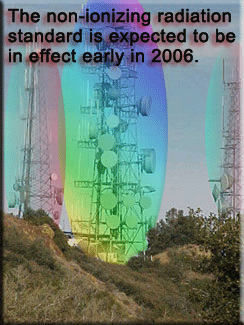 was submitted too late to be reviewed during the 2005 session. Although there is no house bill in place to disapprove it, it is not without its opponents. The North Carolina Association of Broadcasters and the North Carolina Cable Telecommunications Association believe the rules could interfere with routine activities where there is not a risk of a serious injury or death. The Personal Communications Industry Association (PCIA) and other industry groups believe that the proposed exposure standard appears to exceed existing standards. Although this standard is just for the State of North Carolina, the telecommunications associations are aware that other states may quickly adopt the North Carolina language within their state's standards once there is a resolution. The North Carolina Rules Review Commission approved the rewritten rule submitted by the Department of Labor. At least ten letters requesting legislative review were received. The standard could become effective in January or February of 2006. was submitted too late to be reviewed during the 2005 session. Although there is no house bill in place to disapprove it, it is not without its opponents. The North Carolina Association of Broadcasters and the North Carolina Cable Telecommunications Association believe the rules could interfere with routine activities where there is not a risk of a serious injury or death. The Personal Communications Industry Association (PCIA) and other industry groups believe that the proposed exposure standard appears to exceed existing standards. Although this standard is just for the State of North Carolina, the telecommunications associations are aware that other states may quickly adopt the North Carolina language within their state's standards once there is a resolution. The North Carolina Rules Review Commission approved the rewritten rule submitted by the Department of Labor. At least ten letters requesting legislative review were received. The standard could become effective in January or February of 2006.
NATE and ACCSH task force team together to advise OSHA
Beauregard has chaired the federal Advisory Council on Occupational Safety and Health's (ACCSH) tower task force group. His sub-committee was assigned to develop tower-specific regulations and recommendations to OSHA. He presented his initial findings and recommendations to the ACCSH committee during a February 12, 2004 Illinois conference. ACCSH is chaired by Robert Krul of the Roofers International Union. Attending the presentation were Assistant Secretary of Labor John Henshaw and Cleveland area OSHA director Rob Medlock.
A common thread throughout the Beauregard's overview was the need to visit more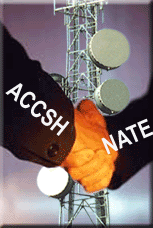 tower construction sites, either with outreach or compliance activities. Medlock believe that the industry would be better served if there was a process in place to have building department officials notify OSHA when a tower is going to be constructed so that OSHA inspectors would be able to visit the site. tower construction sites, either with outreach or compliance activities. Medlock believe that the industry would be better served if there was a process in place to have building department officials notify OSHA when a tower is going to be constructed so that OSHA inspectors would be able to visit the site.
"That's excellent," Medlock said, "there's just nothing in the rulemaking process right now that allows us to do that."
The report also concurred that tower erection accident fatality information was still difficult to measure based upon the various reporting procedures and the total number of employees in the industry erecting and maintaining towers.
NATE provided considerable guidance to Beauregard's group and ACCSH approved a set of proposed construction standards this past October that address the tower construction industry. The safety practices recommended by the workgroup are the practices developed over the last decade by NATE members. NATE is optimistic that OSHA will initiate some rules promulgation and believes that OSHA should accept the premise that communications towers should have their own set of standards. initiate some rules promulgation and believes that OSHA should accept the premise that communications towers should have their own set of standards.
If you want to weigh in on the new communications tower standard with a constructive comment, please visit the discussion forum under the Safety section and add to an existing post  or start a new thread. Your valued comments will be appreciated. or start a new thread. Your valued comments will be appreciated.
Copyright © Wireless Estimator, Inc. Please request reprint permission.
|